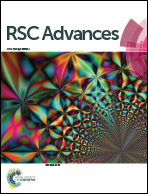Green fabrication of antibacterial polymer/silver nanoparticle nanohybrids by dual-spinneret electrospinning†
Abstract
Nanohybrids from waterborne polyurethane (WPU), poly(vinyl alcohol) (PVA) and silver nanoparticles (AgNPs) with ultrasmall sizes (5.1 ± 0.6 nm) are facilely obtained by directly one-step dual-spinneret electrospinning fabrication from water. SEM and TEM images indicated the nanofibre morphology as designed. Moreover, the elemental distribution mapping indicated the good mixture of WPU/PVA and PVA/AgNPs nanofibers in the mats via such dual-spinneret technique. Also the thermal stability and biocidal activity of the hybrid nanofibers were greatly enhanced by the addition of WPU component and incorporation of Ag nanoparticles without increase of cytotoxicity.


 Please wait while we load your content...
Please wait while we load your content...